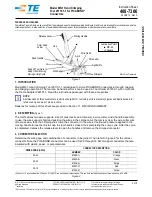
Step 4.
LOCK ASSEMBLY, CAM FOLLOWER and BEARING
R-1, R-11 and R-12
A. Inspect lock pawls and lock handle for damage and wear. Refer to ex-
ploded view.
B. Inspect lock assembly pivot shaft mounted on right lock pawl for wear.
Bearing, R-12 must fit snugly over shaft.
C. Inspect cam follower, R-11 for wear and damage. Make certain that cam
follower nut is tight during assembly.
D. Inspect bearing, R-12 for damage and wear. Bearing must turn freely.
WARNING: Replace all parts that are damaged or worn.
Step 5.
LOCK SPRING ASSEMBLY R-2
A. Inspect body for wear and distortion, particularly in the area where the
body contains the stops for the various spring tension positions. Refer to
exploded view.
B. Inspect spring for damage and distortion. Spring coils must be in contact
with the adjacent coil when spring is relaxed.
The spring must have a definite tension when the spring is set in the position of
maximum tension without material in the clamp. To put the clamp in the maxi-
mum position with clamp fully assembled, adjust lock spring assembly until
adjusting slot nearest to spring engages the shaft on the lock assembly, and
the lock handle is moved to the “Lock Closed” position. Refer to exploded
view .
WARNING:
Replace lock spring assembly that is damaged or if the spring is
distorted or lacking improper tension.
Step 6.
GRIPPNG CAM R-3 and RH-3
A. Inspect cams for chipped or worn teeth. Teeth must be sharp and free of
foreign matter. Inspect the cams for fractures, particularly at the cam pin
hole.
B. RH-3 cams are intended to handle hot lifts only. This cam is identified by
having two 3/16” holes drilled on the outside of the edge of the cam (when
assembled in clamp) between the cam assembly pin and the cam pin.
These holes are approximately 1/2” deep. Hot lift cams are painted red at
time of shipment. Refer to exploded view.
WARNING: Replace cams with worn or damaged teeth, containing frac-
tures or which have elongated pin holes.






































